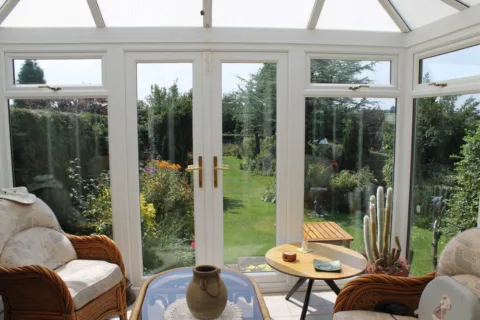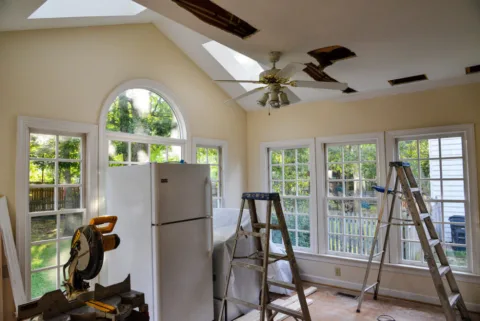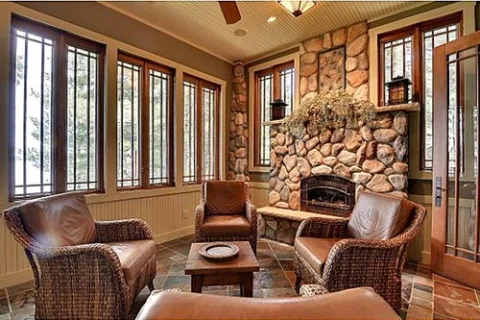I remember vacationing from Pennsylvania to Bonita Beach, Florida as a kid and we stayed with my parents’ friends who had a beautiful “Florida Sunroom.” (I put it in quotes because that’s exactly what my mom and dad called it.)
At the time, I wondered, “Do you actually have to live in Florida to want — or need — a sunroom? Could we have a sunroom back in Pennsylvania?”
Well, as it turns out — I could. And so can you!
If you have the space for a sunroom addition and the money to remodel your home, then a sunroom might seem like an appealing investment. Especially since:
- Sunrooms provide a great place to escape the rest of your home — without actually leaving it.
- Sunrooms tend to have large windows (or they consist of complete glass enclosures) that allow you to be one with nature from a protected space.
While it may seem like sunshine and roses, sunrooms aren’t necessarily the best choice for every home.
If you plan to put on a sunroom addition (or hire a contractor to do the work for you), the following are a few pros and cons you should carefully consider first.
What Are The Upsides Of Sunrooms?
Sunrooms are affordable. They are, by far, one of the most cost-effective home improvement projects. Besides being more cost-effective than traditional room additions, sunrooms offer more versatility and they’re easier to maintain.
Here are a few more benefits of adding a sunroom to your home:
#1 – There are plenty of options.
You can choose from different sunrooms styles, including:
You can also choose either a 3-season or 4-season sunroom:
- A 3-season sunroom is basically a covered space outdoors that is completely surrounded by single-pane glass — so it’s mostly used during the warmer months.
- A 4-season sunroom is an actual extension of the house that is fully insulated — so it can be enjoyed comfortably year round.
#2 – They’re affordable.
The cost of your sunroom is directly related to its size and the amount of work that needs to go into its construction.
If you have a small space that you’re converting into a sunroom, it might surprise you how affordable it can be.
#3 – They add natural light.
Most sunrooms let in a lot of natural light — so much so that it may reduce your cost of using electric lights inside the house.
A sunroom can also affect how big your living space feels. Even a tiny sunroom can seem large, thanks to the windows and the amount of light it lets in.
Daylit environments increase occupant productivity and comfort, and provide the mental and visual stimulation necessary to regulate human circadian rhythms. Source
#4 – They’re versatile.
Unlike other rooms in your home — such as the kitchen or bathroom — your sunroom can be used for pretty much anything.
You can make it a craft room, a reading room, or simply a lounging area. There’s no set way you have to use the space, so let your imagination run wild!
What Are The Downsides Of A Sunroom Addition?
As with anything in life — there are a few downsides to adding a sunroom. For starters, it won’t be plumbed, and traditionally it isn’t wired for electricity. Although, with digital devices as our constant companions these days, most homeowners now insist that all room additions include a number of outlets.
Here are some other downsides of adding on a sunroom:
#1 – The costs can be high.
If you have a large unused space inside your home that you’re turning into a sunroom, the costs can quickly add up.
It may cost even more if you’re building an entirely new addition onto the home!
Be sure to carefully research the cost of materials and labor — so you’ll know exactly how much your sunroom will cost to build.
#2 – Your home’s resale value might not improve.
Some people say that adding a sunroom to your home adds to the resale value. But U.S. World News & Report reported that sunrooms are one of the worst home improvements — in terms of return on investment (ROI).
Based on the averages, you might only get a 51% return when you sell your home.
That said, even with wiring, a basic sunroom still has a lower per-foot cost than any other type of room addition.
#3 – The lack of privacy can be problematic.
Sunrooms are open and bright… and they let you see out in the world. However, this also means the world can see in.
You may be able to get some giant window coverings to offer a little more privacy. But keep in mind that sunrooms are meant to be open — to let the light shine in.
#4 – A sunroom could actually increase your energy usage.
Three-season sunrooms aren’t very energy efficient, particularly in the wintertime.
Sure, on sunny days a sunroom can trap heat inside to keep things warmer — but that heat tends to escape as nighttime rolls around.
Four-season sunrooms tend to function better. But they come at a higher cost.
https://youtu.be/fTyYQomJeLs
Any type of addition onto your home is a big decision that deserves careful consideration.
Before you jump at the opportunity to put a sunroom on that lesser used space in your home, think long and hard about the cons as well as the pros. Then, if you feel it’s a good investment for your money and home, build away!
Before You Begin A Sunroom Addition
In addition to the links I’ve included above, here are some other resources to help you decide if a sunroom is right for you:








